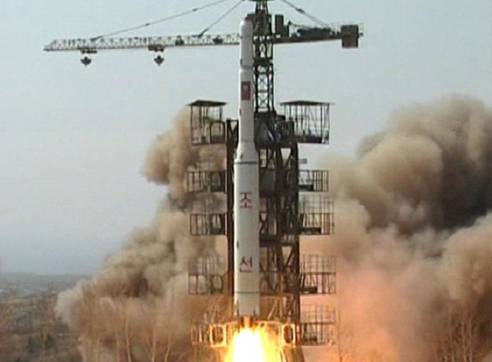George Leopold
4/13/2012 3:15 PM EDT
乔治・利奥波德
2012年4月13日3:15美东时间下午
华盛顿 - 北朝鲜的三级Unha-3火箭(3月12日)的失败有可能是剧烈的震动引起的。据火箭专家分析,发射约一分钟后,飞行轨迹的早期……(原版英文如下)
WASHINGTON �C The failure of North Korea’s three-stage Unha-3 rocket on Thursday (March 12) was most likely caused by severe vibrations at an early point in the flight trajectory known as Max Q, or maximum dynamic pressure, about one minute into the launch, according to a rocket expert.
While the lower stages of the North Korean rocket continued to function for several minutes, resonance at the top of the launch vehicle resulted in “catastrophic disassembly of the third stage at Max Q,” said Charles Vick, senior technical and space policy analyst at GlobalSecurity.org. “The vibrations just tore it apart.”
The third stage along with a satellite payload shroud failed about one minute into flight, analysts said. North Korea claimed the flight test, which drew international condemnation, was designed to place a satellite into a polar orbit. But many experts, including Vick, believe Pyongyang was testing the three-stage rocket for use as a ballistic missile.

North Korea’s Unha-3 rocket lifts off on Thursday. The planned orbital flight lasted only about four minutes
The Unha-3 is based on the TaepoDong-2 missile. The third stage was jointly developed by North Korean and Iranian rocket engineers. The latest failure is the third for North Korea, prompting Vick to conclude that North Korea will likely look elsewhere for a new third stage design.
He said the timing of the failure at about 60 seconds into the flight points to severe vibration at Max Q, the point where aerodynamic stresses on rocket traveling through the atmosphere are greatest. Unlike American rockets, the North Koreans lack the ability to throttle their liquid-fueled rockets up or down to diminished the stresses at Max Q.
According to U.S. military observers, the failed orbital launch lasted about four minutes. Vick estimated that the Unha-3’s first stage fired for nearly 2 minutes before dropping into the sea about 102 miles west of Seoul, South Korea. Intelligence reports estimated parts of the rocket traveled on a southern trajectory over the Yellow Sea as far as 151 km (about 94 miles).
Given the severe vibrations and the early failure of the third stage, Vick said he was surprised that the other two stages held together as long as they did. He estimated the Unha-3 might have reached a velocity of about Mach 4, well below the speed needed to achieve orbit.
North Korea said it was aiming to place its satellite in a 500-km circular polar orbit.

